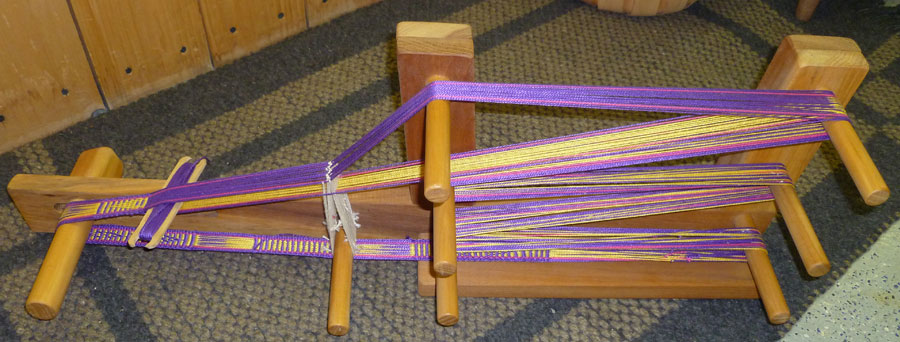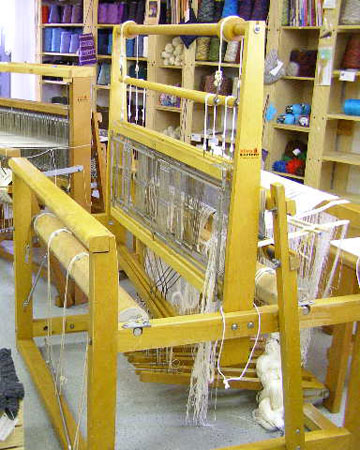Equipment
Looms
The job of a loom is to hold the warp threads in place with tension so the weft threads can be woven into it to form fabric. It lifts or lowers some of the thread so the weft (the weaving thread) can pass through it. When these threads are lifted or lowered the horizontal threads form a triangular opening called a shed. By varying the number and position of the threads that are raised and those that stay down we get the patterns in weaving. To get some of the warp threads to raise, they pass through an eye in the heddle. The heddles in turn are held in a frame called the harness and the harness is raised by the operating lever. On some looms the operating lever is lifted by hand and on other looms it is lifted with pedals or treadles that are worked with your feet.
At the front and the back of the loom you have the tension or take-up wheels to give the proper tension to the warp threads. The roller at the back of the loom on which the warp is wound is the warp beam. The roller at the front of the loom on which the finished fabric is wound is the cloth beam. The front horizontal bar over which the woven fabric passes is the breast beam. The horizontal bar at the back is the back beam.
The beater has a dual purpose: it holds the reed and with it beats the weft into position so the weaving is smooth and even. The reed spaces the warp threads evenly apart. It also does the beating of the warp threads.
Table Loom
 Table looms are small looms that use levers to lift the warp threads. They are called table looms because they are transportable and usually sit on a table. A table loom is great for small projects, sampling, workshops, and classroom use.
Table looms are small looms that use levers to lift the warp threads. They are called table looms because they are transportable and usually sit on a table. A table loom is great for small projects, sampling, workshops, and classroom use.
Inkle Loom
 An Inkle loom is a small portable loom where the warp is raised and lowered manually. The weave structure on an Inkle loom is warp faced meaning the warp completely covers the weft. Inkle looms are used for narrow weaving and are great for straps and belts.
An Inkle loom is a small portable loom where the warp is raised and lowered manually. The weave structure on an Inkle loom is warp faced meaning the warp completely covers the weft. Inkle looms are used for narrow weaving and are great for straps and belts.
Floor Looms
A floor loom is a strong upright loom that holds many threads. Floor looms are identical in all respects to the table loom, except they have foot pedals or treadles on the floor, instead of levers at the top or side of the loom to raise the harnesses. Floor looms also have rachets instead of the tension wheels to operate the cloth and warp beams. There are many different kinds of floor looms. We will focus on three different types.
Jack Loom
 Jack Looms have a rising shed. This means the weft threads are lifted from the horizontal position to make an opening for the warp threads to pass through. Each shaft operates independently. The jack mechanism, which can be above or below the shafts, lifts the shafts selected. When one shaft or group of shafts is raised, the rest remain in neutral position. Located between the treadles and the jacks, the lams of the jack loom facilitate the lifting of multiple shafts by a single treadle. Jack looms are ideal for the weaver who wants to try many different weave structures on account of the independent nature of the shafts and the relative ease of changing the tie-up. However, jack looms require more physical effort than counterbalance looms of a similar size.
Jack Looms have a rising shed. This means the weft threads are lifted from the horizontal position to make an opening for the warp threads to pass through. Each shaft operates independently. The jack mechanism, which can be above or below the shafts, lifts the shafts selected. When one shaft or group of shafts is raised, the rest remain in neutral position. Located between the treadles and the jacks, the lams of the jack loom facilitate the lifting of multiple shafts by a single treadle. Jack looms are ideal for the weaver who wants to try many different weave structures on account of the independent nature of the shafts and the relative ease of changing the tie-up. However, jack looms require more physical effort than counterbalance looms of a similar size.
Counterbalance Loom
 Counterbalance looms usually are limited to four shafts: two pairs of two shafts each which are balanced against each other over a series of rollers, pulleys, or levers. This loom type has a sinking shed. This means when you lower shafts one and three, shafts two and four automatically rise, and when you lower shafts two and four, shafts one and three automatically rise. In reality the opening of the shed doesn't actually sink; it is really a symmetrical shed in which the upper and lower sets of threads are displaced equally. Counterbalance looms are best suited to balanced weaves; they are quiet to operate and easy on the weaver's back and legs.
Counterbalance looms usually are limited to four shafts: two pairs of two shafts each which are balanced against each other over a series of rollers, pulleys, or levers. This loom type has a sinking shed. This means when you lower shafts one and three, shafts two and four automatically rise, and when you lower shafts two and four, shafts one and three automatically rise. In reality the opening of the shed doesn't actually sink; it is really a symmetrical shed in which the upper and lower sets of threads are displaced equally. Counterbalance looms are best suited to balanced weaves; they are quiet to operate and easy on the weaver's back and legs.
Production Loom
 Production Looms are large sturdy looms that are built for production of long bolts of fabric; some up to one hundred yards in length. Because these looms are usually quite wide they come with a fly shuttle to make it easier for the weaver to throw the shuttle back and forth. Many have multiple shafts ranging anywhere from eight to thirty-two which allows the weaver to create more intricate designs. They also may be computerized to help with the intricate patterns. Even though some of these looms are computerized it still is considered hand weaving as a person still has to dress the loom by hand and weave off the fabric by hand.
Production Looms are large sturdy looms that are built for production of long bolts of fabric; some up to one hundred yards in length. Because these looms are usually quite wide they come with a fly shuttle to make it easier for the weaver to throw the shuttle back and forth. Many have multiple shafts ranging anywhere from eight to thirty-two which allows the weaver to create more intricate designs. They also may be computerized to help with the intricate patterns. Even though some of these looms are computerized it still is considered hand weaving as a person still has to dress the loom by hand and weave off the fabric by hand.
Shuttles
 A shuttle is the piece of equipment used to pass your weft back and forth through the warp. The weft is either wound directly on a shuttle or on a bobbin or pirn. Shuttles come in different sizes and shapes, each designed for a different kind of weft.
A shuttle is the piece of equipment used to pass your weft back and forth through the warp. The weft is either wound directly on a shuttle or on a bobbin or pirn. Shuttles come in different sizes and shapes, each designed for a different kind of weft.
Stick
Stick shuttles are the easiest to make and the cheapest to buy. They come in many styles and lengths. They are mostly used with rigid heddle, tapestry, or small frame looms but are also used on floor looms for sampling, or carrying a supplementary weft over a short distance, or weaving a very narrow fabric or band.
Boat
Boat shuttles are faster to use with medium to fine wefts. They require a bobbin and a bobbin winder to use. Boat shuttles offer greater efficiency than stick shuttles. They come in many different lengths and sizes.
Rag
Rag shuttles are used for rag rug weaving. They are sturdy and broadly built to accommodate fabric strips.
Fly
Fly shuttles are very expensive and used on production looms. They look similar to a boat shuttle but are longer and very heavy. They have a metal tip at each end and a tension device that can be adjusted for the weight of yarn being used. They require a pirn and a pirn winder to use.
Ski
Ski shuttles are used for holding heavy yarns. They are longer than a boat shuttle and resemble the shape of a ski.
Warping
Warping means preparing the warp threads of the proper number and proper length so they can be put onto the loom.
Warping Board
A warping board is used to measure yarn into organized rows the length needed for your woven project. Once the warp is wound onto a warping board it can be put on the loom.
Warping Mill
A warping Mill can be used instead of a warping board to measure your warp. The difference between the two is their shape and the width and length of warp you can wind on them. A warping mill is used to wind longer warps.
Cone Rack
A cone rack is used to hold yarn on cones. The yarn is placed on a cone rack and then is wound on a warping board or warping mill. It is also used to hold the cones of yarn when warping a loom sectionally.
Raddle
A Raddle is used when warping from back to front. It is the tool used to separate and spread the warp to the correct width when rolling it onto the warp beam.
Spool Rack
A spool rack serves the same purpose as a cone rack only on a smaller scale. Instead of cones it holds spools of yarn.
Sley Hooks
Sley hooks, sometimes called reed hooks, are short, flat hooks used for drawing the warp threads through the dents in the reed. This is called sleying the reed.
Tension Box
A tension box is used to keep an even tension on warp going from the spool or cone rack to the sectional warp beam.
Warping Paddle
A warping paddle is used to save time measuring many warp threads at once instead of one at a time.
Lease Sticks
Lease sticks are a pair of flat or round sticks with a hole at each end. They are used in some methods of warping for holding the cross or creating extra friction during beaming.
Reed
A reed is the steel piece that fits into the beater bar of the loom. Reeds come in different sizes and determine how close together your warp threads will be.
Heddles
There are five types of heddles: wire, inserted eye, flat steel, string, and nylon. The metal types are self-adjusting, meaning they slide easily on the heddle bars and thus space themselves out after threading. String and nylon heddles must be positioned by hand.
